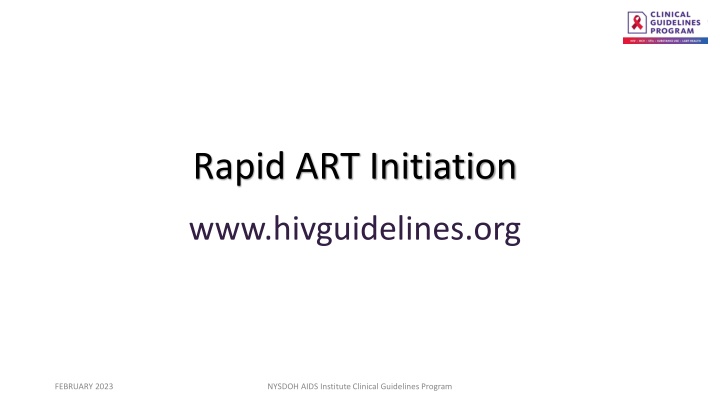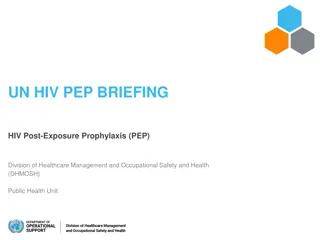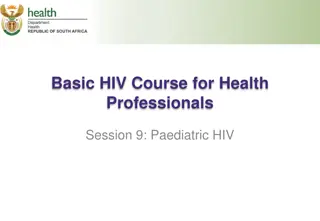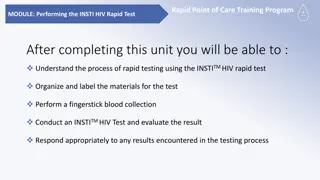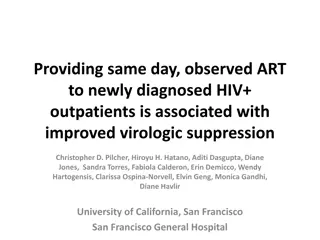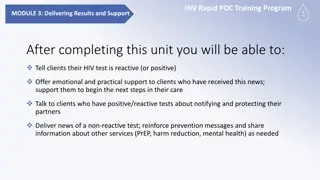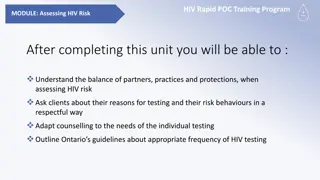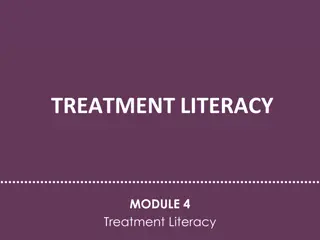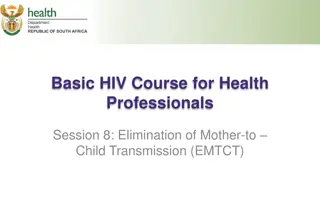Rapid ART Initiation Guidelines for Managing HIV Infection
This guideline by NYSDOH AIDS Institute outlines recommendations for rapidly initiating antiretroviral therapy (ART) in patients with HIV infection. It emphasizes prompt initiation of ART based on patient characteristics, even prior to confirmatory testing results. The guideline also stresses the importance of patient counseling, evaluation, and involvement in the treatment decision-making process to enhance adherence and successful outcomes. Healthcare providers are encouraged to seek support from experienced HIV care providers and consider funding sources for sustainable ART access. The recommendations focus on timely ART initiation, patient readiness assessment, addressing adherence barriers, and patient-centered care coordination.
Download Presentation

Please find below an Image/Link to download the presentation.
The content on the website is provided AS IS for your information and personal use only. It may not be sold, licensed, or shared on other websites without obtaining consent from the author.If you encounter any issues during the download, it is possible that the publisher has removed the file from their server.
You are allowed to download the files provided on this website for personal or commercial use, subject to the condition that they are used lawfully. All files are the property of their respective owners.
The content on the website is provided AS IS for your information and personal use only. It may not be sold, licensed, or shared on other websites without obtaining consent from the author.
E N D
Presentation Transcript
Rapid ART Initiation www.hivguidelines.org FEBRUARY 2023 NYSDOH AIDS Institute Clinical Guidelines Program
Purpose of This Guideline Purpose of This Guideline Provides guidance for choosing safe and efficacious ART regimens based on known patient characteristics, before results of recommended resistance testing or baseline laboratory testing are available. Identifies antiretroviral regimens to avoid for rapid ART initiation. Provides guidance for recognizing when rapid ART initiation is not appropriate. Encourages clinicians to seek the assistance of an experienced HIV care provider when managing patients with extensive comorbidities. Integrates current evidence-based clinical recommendations into the healthcare-related implementation strategies of the New York State Ending the Epidemic initiative. Provides guidance on funding sources for sustainable access to ART. FEBRUARY 2023 NYSDOH AIDS Institute Clinical Guidelines Program www.hivguidelines.org
Recommendations: Recommendations: Rationale for Rapid ART Initiation Rationale for Rapid ART Initiation Clinicians should recommend ART for all patients with a diagnosis of HIV infection. (A1) Clinicians should offer rapid initiation of ART preferably on the same day (A1) or within 72 hours to all individuals who are candidates for rapid ART initiation (see text) and who have: A confirmed HIV diagnosis (A1), or A reactive HIV screening result pending results of a confirmatory HIV test (A2), or Acute HIV infection, i.e., are HIV antibody negative and HIV RNA positive (A2) Clinicians should counsel patients with HIV-seronegative partners about the reduction of HIV transmission risk after effective ART is initiated and viral suppression is achieved and should strongly recommend ART for patients with HIV-seronegative partners. (A1) FEBRUARY 2023 NYSDOH AIDS Institute Clinical Guidelines Program www.hivguidelines.org
Recommendations: Recommendations: Rationale for Rapid ART Initiation Rationale for Rapid ART Initiation, continued Clinicians should evaluate and prepare patients for ART initiation as soon as possible; completion of the following should not delay initiation: Discuss benefits and risks of ART with the patient. (A3) Assess patient readiness. (A3) Identify and ameliorate factors that might interfere with successful adherence to treatment, including inadequate access to medication, inadequate supportive services, psychosocial factors, active substance use, or mental health disorders. (A2) Clinicians should refer patients for supportive services as necessary to address modifiable barriers to adherence. An ongoing plan for coordination of care should be established. (A3) FEBRUARY 2023 NYSDOH AIDS Institute Clinical Guidelines Program www.hivguidelines.org
Recommendations: Recommendations: Rationale for Rapid ART Initiation Rationale for Rapid ART Initiation, continued Clinicians should involve patients in the decision-making process regarding initiation of ART and which regimen is most likely to result in adherence. The patient should make the final decision of whether and when to initiate ART. (A3) If the patient understands the benefits of rapid initiation but declines ART, the clinician should revisit the topic of initiation as soon as possible. Clinicians should initiate ART in patients with advanced HIV (or AIDS) even if barriers to adherence are present; in these cases, referrals to specialized adherence programs should be made for intensified adherence support. (A2) After ART has been initiated, the clinician should monitor the patient s response to therapy or consult with an experienced HIV care provider. (A2) FEBRUARY 2023 NYSDOH AIDS Institute Clinical Guidelines Program www.hivguidelines.org
Key Points: Key Points: Rationale for Rapid ART Initiation Rationale for Rapid ART Initiation Rapid ART initiation, the standard of care in New York State, is efficacious, safe, and highly acceptable, with few patients declining the offer of immediate ART. Patients with active substance use, untreated mental health conditions, immigration issues, or unstable housing deserve the highest standard of HIV care, including the option of rapid ART initiation. Potential barriers to medication adherence and care continuity can be addressed with appropriate counseling and linkage to support services. FEBRUARY 2023 NYSDOH AIDS Institute Clinical Guidelines Program www.hivguidelines.org
Recommendations: Recommendations: Counseling and Education Before Initiating ART Counseling and Education Before Initiating ART Clinicians should counsel and educate patients regarding the following: Basic information about HIV, CD4 cell count, viral load, and resistance (A3) Available treatment options and potential risks and benefits of therapy (see text) (A3) Optimal adherence requirements to avoid development of viral drug resistance (A2) Use of safer-sex practices during the first 6 months after ART is started or until the patient s viral load is suppressed, to prevent HIV transmission or superinfection (A3) Clinicians should involve the patient in the decision-making process regarding initiation of ART. (A3) FEBRUARY 2023 NYSDOH AIDS Institute Clinical Guidelines Program www.hivguidelines.org
Recommendations: Recommendations: Protocol for Rapid ART Initiation Protocol for Rapid ART Initiation To determine whether a patient is a candidate for rapid ART initiation, the clinician should confirm that the individual has (A1): A new reactive point-of-care HIV test result, a confirmed HIV diagnosis, suspected acute HIV infection, or known HIV infection, and No prior ART (i.e., treatment naive, excluding PrEP and PEP) or limited prior use of antiretroviral medications, and No medical conditions or specific opportunistic infections that require deferral of ART initiation, including suspected cryptococcal or TB meningitis and CMV retinitis Clinicians should perform baseline laboratory testing listed in Baseline Laboratory Testing Checklist for all patients who are initiating ART immediately; ART can be started while awaiting laboratory test results. (A3) FEBRUARY 2023 NYSDOH AIDS Institute Clinical Guidelines Program www.hivguidelines.org
Selected Good Practice Reminders: Selected Good Practice Reminders: Protocol for Rapid ART Initiation Protocol for Rapid ART Initiation Ensure that patients with a reactive HIV antibody screening test that is pending confirmation understand the benefits of rapid ART initiation, as well as the following: Reactive screening test results are not formally diagnostic, because false-positive results are still possible. A confirmatory (diagnostic) HIV test will be performed. ART will be discontinued if the confirmatory test result is negative and continued if it is positive. The benefit of starting ART early, after a presumptive positive screening test, outweighs the negligible risk of taking ART for a few days and then stopping it if confirmed HIV negative. Provide the result of the confirmatory HIV test as soon as it is available; discontinue ART if the result is negative and reinforce adherence and next steps if it is positive. If a patient declines rapid ART initiation, discuss options for deferral of ART initiation, link the patient with HIV primary care, and outline next steps. FEBRUARY 2023 NYSDOH AIDS Institute Clinical Guidelines Program www.hivguidelines.org
Protocol for Rapid ART Initiation Protocol for Rapid ART Initiation Note: a. ART can be started while awaiting laboratory test results. FEBRUARY 2023 NYSDOH AIDS Institute Clinical Guidelines Program www.hivguidelines.org
Key Point: Key Point: Reactive HIV Screening Test Result Reactive HIV Screening Test Result Patients with a new reactive HIV test result can be retested using a second point-of-care test from a different manufacturer than that of the first test, if available, to verify the result. See the NYSDOH AI guideline HIV Testing > Appendix: HIV Immunoassays Available in New York State for a list of available point-of-care HIV tests. FEBRUARY 2023 NYSDOH AIDS Institute Clinical Guidelines Program www.hivguidelines.org
Resources: Health Literacy Resources: Health Literacy National Library of Medicine: An Introduction to Health Literacy Health Literacy Tool Shed Agency for Healthcare Research and Quality: Short Assessment of Health Literacy Spanish and English Rapid Estimate of Adult Literacy in Medicine Short Form Short Assessment of Health Literacy for Spanish Adults FEBRUARY 2023 NYSDOH AIDS Institute Clinical Guidelines Program www.hivguidelines.org
Medical History Checklist Medical History Checklist When taking a medical history before rapid ART initiation, ask about: Date and result of last HIV test Serostatus of sex partners and their ART regimens if known Previous use of antiretroviral medications, including as PrEP or PEP, with dates of use Comorbidities, including a history of renal or liver disease, particularly hepatitis B virus infection Prescribed and over-the-counter medications Drug allergies Substance use Any signs or symptoms of active cryptococcal or TB meningitis, or visual changes associated with CMV retinitis (see discussion of clinical manifestations in the DHHS Guidelines for the Prevention and Treatment of Opportunistic Infections in Adults and Adolescents with HIV > Cryptococcosis, Mycobacterium tuberculosis Infection and Disease, and Cytomegalovirus Disease) Psychiatric history, particularly depressive or psychotic symptoms or any history of suicidality Possible pregnancy and childbearing plans in individuals of childbearing potential FEBRUARY 2023 NYSDOH AIDS Institute Clinical Guidelines Program www.hivguidelines.org
Baseline Laboratory Testing Checklist Baseline Laboratory Testing Checklist HIV-1/2 Ag/Ab immunoassay HIV quantitative viral load test Baseline HIV genotypic resistance profile Baseline CD4 cell count Testing for hepatitis A, B, and C viruses Comprehensive metabolic panel (creatinine clearance, hepatic profile) Pregnancy test for individuals of childbearing potential Urinalysis Syphilis, gonorrhea, and chlamydia screening as per CDC > Sexually Transmitted Infections Treatment Guidelines, 2021 > Screening Recommendations FEBRUARY 2023 NYSDOH AIDS Institute Clinical Guidelines Program www.hivguidelines.org
Recommendations: General Principles in Recommendations: General Principles in Choosing a Regimen for Rapid ART Initiation Choosing a Regimen for Rapid ART Initiation Clinicians should involve their patients when deciding which ART regimen is most likely to result in adherence. (A3) Before initiating ART, clinicians should: Assess the patient s prior use of antiretroviral medications, including as PrEP, which may increase the risk for baseline resistance. (A2) Assess for any comorbidities and chronic coadministered medications that may affect the choice of regimen for initial ART. (A2) At the time of HIV diagnosis, obtain genotypic resistance testing for the protease (A2), reverse transcriptase (A2), and integrase (B2) genes. Ask individuals of childbearing potential about the possibility of pregnancy, their reproductive plans, and their use of contraception. (A3) FEBRUARY 2023 NYSDOH AIDS Institute Clinical Guidelines Program www.hivguidelines.org
Recommendations: General Principles in Recommendations: General Principles in Choosing a Regimen for Rapid ART Initiation Choosing a Regimen for Rapid ART Initiation, continued For ART-naive patients, clinicians should select an initial ART regimen that is preferred; see Table 1 in full guideline. (A1) Clinicians should reinforce medication adherence regularly. (A3) Clinicians should obtain a viral load test 4 weeks after ART initiation to assess the response to therapy. (A3) See the NYSDOH AI guideline Virologic and Immunologic Monitoring in HIV Care. FEBRUARY 2023 NYSDOH AIDS Institute Clinical Guidelines Program www.hivguidelines.org
Selected Good Practice Reminders: General Selected Good Practice Reminders: General Principles in Choosing a Regimen for Rapid ART Initiation Principles in Choosing a Regimen for Rapid ART Initiation Follow up within 24 to 48 hours, by telephone or another preferred method, with a patient who has initiated ART to assess medication tolerance and adherence. If feasible, schedule an in-person visit for 7 days after ART initiation. FEBRUARY 2023 NYSDOH AIDS Institute Clinical Guidelines Program www.hivguidelines.org
Preferred Regimens for Patients Not on PrEP Preferred Regimens for Patients Not on PrEP Regimen Comments TAF 25 mg/FTC/BIC Biktarvy (A1) TAF/FTC/BIC is available as a single-tablet formulation, taken once daily. TAF/FTC should not be used in patients with CrCl <30 mL/min; re-evaluate after baseline laboratory testing results are available. This regimen contains 25 mg of TAF, unboosted. Magnesium- or aluminum-containing antacids may be taken 2 hours before or 6 hours after BIC; calcium-containing antacids or iron supplements may be taken simultaneously if taken with food. TAF 25 mg/FTC and DTG Descovy and Tivicay (A1) TAF/FTC should not be used in patients with CrCl <30 mL/min; re-evaluate after baseline laboratory testing results are available. This regimen contains 25 mg of TAF, unboosted. Administer as 2 tablets once daily. Magnesium- or aluminum-containing antacids may be taken 2 hours before or 6 hours after DTG; calcium-containing antacids or iron supplements may be taken simultaneously if taken with food. Documented DTG resistance after initiation in treatment-naive patients is rare. FEBRUARY 2023 NYSDOH AIDS Institute Clinical Guidelines Program www.hivguidelines.org
Preferred Regimens for Patients Not on PrEP Preferred Regimens for Patients Not on PrEP, continued Regimen (rating) Comments TAF/FTC/DRV/COBI is available as a single-tablet formulation, taken once daily. This regimen contains 10 mg TAF, boosted. TAF/FTC should not be used in patients with CrCl <30 mL/min; re- evaluate after baseline laboratory testing results are available. Pay attention to drug-drug interactions. TAF 10 mg/FTC/DRV/COBI Symtuza (A2) FEBRUARY 2023 NYSDOH AIDS Institute Clinical Guidelines Program www.hivguidelines.org
Regimens for Patients Who Have Taken TDF/FTC Regimens for Patients Who Have Taken TDF/FTC as PrEP Since Their Last Negative HIV Test as PrEP Since Their Last Negative HIV Test Regimen (rating) Comments TAF 25 mg/FTC and DTG Descovy and Tivicay (A1) TAF/FTC should not be used in patients with CrCl <30 mL/min; re-evaluate after baseline laboratory testing results are available. Documented DTG resistance after initiation in treatment-naive patients is rare. Magnesium- or aluminum-containing antacids may be taken 2 hours before or 6 hours after DTG; calcium-containing antacids or iron supplements may be taken simultaneously if taken with food. TDF may be substituted for TAF; TDF/FTC is available as a single tablet (brand name Truvada). 3TC may be substituted for FTC; 3TC/TDF is available as a single tablet (brand name Cimduo). FEBRUARY 2023 NYSDOH AIDS Institute Clinical Guidelines Program www.hivguidelines.org
Regimens for Patients Who Have Taken TDF/FTC Regimens for Patients Who Have Taken TDF/FTC as PrEP Since Their Last Negative HIV Test as PrEP Since Their Last Negative HIV Test, continued Regimen (rating) Comments TAF 25 mg/FTC/BIC; Biktarvy (A1) TAF/FTC/BIC is available as a single-tablet formulation, taken once daily. TAF/FTC should not be used in patients with CrCl <30 mL/min; re-evaluate after baseline laboratory testing results are available. This regimen contains 25 mg of TAF, unboosted. Magnesium- or aluminum-containing antacids may be taken 2 hours before or 6 hours after BIC; calcium-containing antacids or iron supplements may be taken simultaneously if taken with food. TAF 10 mg/FTC/DRV/COBI; Symtuza (B2) TAF/FTC/DRV/COBI is available as a single-tablet formulation, taken once daily. This regimen contains 10 mg TAF, boosted. TAF/FTC should not be used in patients with CrCl <30 mL/min; re-evaluate after baseline laboratory testing results are available. Pay attention to drug-drug interactions. FEBRUARY 2023 NYSDOH AIDS Institute Clinical Guidelines Program www.hivguidelines.org
Regimen for Patients Who Have Taken CAB LA as Regimen for Patients Who Have Taken CAB LA as PrEP Within the Previous 14 Months PrEP Within the Previous 14 Months Regimen (rating) Comments TAF 10 mg/FTC/DRV/COBI Symtuza (A2) TAF/FTC/DRV/COBI is available as a single-tablet formulation, taken once daily. This regimen contains 10 mg TAF, boosted. TAF/FTC should not be used in patients with CrCl <30 mL/min; re-evaluate after baseline laboratory testing results are available. Pay attention to drug-drug interactions. FEBRUARY 2023 NYSDOH AIDS Institute Clinical Guidelines Program www.hivguidelines.org
Medications to Avoid Medications to Avoid Medications Comments Rating ABC RPV EFV DTG/3TC ABC should be avoided unless a patient is confirmed to be HLA-B*5701 negative. RPV should be administered only in patients confirmed to have a CD4 cell count 200 cells/mm3 and a viral load <100,000 copies/mL. EFV is not as well tolerated as other antiretroviral medications, and NNRTIs have higher rates of resistance. DTG/3TC requires baseline resistance testing and is not recommended when HBV status is unknown. A3 FEBRUARY 2023 NYSDOH AIDS Institute Clinical Guidelines Program www.hivguidelines.org
Recommendations: Recommendations: Long Long- -Term Nonprogressors and Elite Controllers Term Nonprogressors and Elite Controllers Clinicians should individualize decisions to initiate ART in long-term nonprogressors (A2) and elite controllers (A3). Clinicians should consult with an experienced HIV care provider when considering whether to initiate ART in long-term nonprogressors and elite controllers. (A3) FEBRUARY 2023 NYSDOH AIDS Institute Clinical Guidelines Program www.hivguidelines.org
Recommendations: Recommendations: Patients With Acute Opportunistic Infections Patients With Acute Opportunistic Infections Clinicians should recommend that patients beginning treatment for acute OIs initiate ART within 2 weeks of OI diagnosis (see next recommendation for exceptions). (A1) Clinicians should not immediately initiate ART in patients with TB meningitis or cryptococcal meningitis (A1) or cytomegalovirus retinitis. (A3) Clinicians should consult with a care provider experienced in managing ART in patients with acute OIs. (A3) For patients with all other manifestations of TB, clinicians should initiate ART as follows: For patients with CD4 counts 50 cells/mm3: as soon as they are tolerating anti-TB therapy and no later than 8 to 12 weeks after initiating anti-TB therapy (A1) For patients with CD4 counts <50 cells/mm3: within 2 weeks of initiating anti- TB therapy (A1) NYSDOH AIDS Institute Clinical Guidelines Program www.hivguidelines.org FEBRUARY 2023
Other Special Considerations Other Special Considerations For recommendations on initiating ART in pregnant women with HIV, refer to the DHHS Recommendations for the Use of Antiretroviral Drugs During Pregnancy and Interventions to Reduce Perinatal HIV Transmission in the United States. Initial ART regimens for patients with chronic HBV infection must include NNRTIS that are active against HBV. See the NYSDOH AI guideline Prevention and Management of Hepatitis B Virus Infection in Adults With HIV. In patients with HIV/HCV coinfection, attention should be paid to interactions between planned ART and HCV therapy. See the NYSDOH AI guideline Treatment of Chronic Hepatitis C Virus Infection in Adults > Recommended DAA Treatment Regimens. FEBRUARY 2023 NYSDOH AIDS Institute Clinical Guidelines Program www.hivguidelines.org
Need Help? Need Help? NYSDOH AIDS Institute Clinical Guidelines Program www.hivguidelines.org
Access the Guideline Access the Guideline www.hivguidelines.org > Rapid ART Initiation Also available: Printable pocket guide and PDF NYSDOH AIDS Institute Clinical Guidelines Program www.hivguidelines.org
